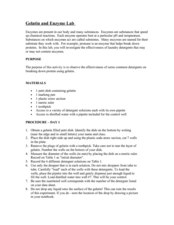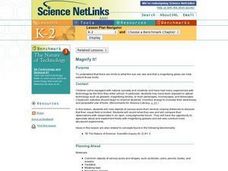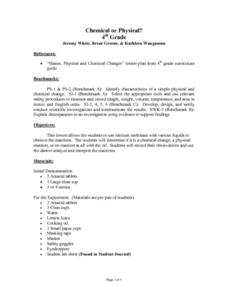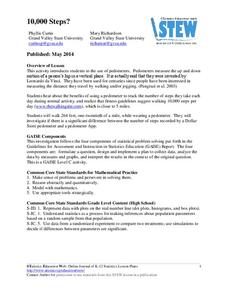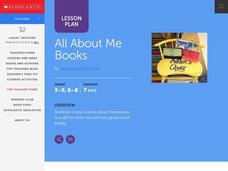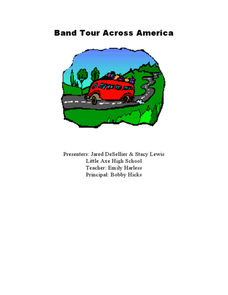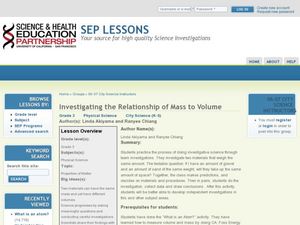Curated OER
Gelatin and Enzyme Lab
Students observe the effectiveness of detergents on breaking down proteins. In this investigative lesson plan students participate in an activity that shows how proteins are broken down in gelatin and fill out a worksheet.
Curated OER
Magnify It!
Learners explain that there are limits to what the eye can see and that a magnifying glass can help extend those limits. They examine an object with the magnifying glass and draw the size and shape of what they see as accurately as they...
Curated OER
Picket Fence Around the Garden
Students design different shaped plots and determine the perimeter, area and shape of each. They compare the shapes that have the same area but may have different perimeters.
Curated OER
How Has Technology Affected the Presidential Election Process in the U.S.?
Students measure technological advancements as they consider how they impacted the election process in the United States. In this presidential politics lesson, students research technological changes since the 1900's and create...
Curated OER
Creating a Structure Lab
Students construct a paper structure that supports a standard hard cover textbook at least 12 inches above a flat sturdy surface for a minimum of 30 seconds. They explain what a blueprint is. Students build the structure entirely out of...
Curated OER
Chemical or Physical?
Fourth graders make observations of the reactions that happens between calcium carbonate and various liquids. During the experiment the students determine if there is a chemical change, a physical reaction, or no reaction when they mix...
Statistics Education Web
10,000 Steps?
Conduct an experiment to determine the accuracy of pedometers versus pedometer apps. Class members collect data from each device, analyze the data using a hypothesis test, and determine if there is a significant difference between the...
Curated OER
Sphere Dressing
Geometric design makes a fashion statement! Challenge learners to design a hat to fit a Styrofoam model. Specifications are clear and pupils use concepts related to three-dimensional objects including volume of irregular shapes and...
US Department of Agriculture
Sink or Float?
Will it sink or will it float? Learners predict the outcome as they drop random objects into a container of water. Then, they keep track of the results and record the data in a t-chart to draw a final conclusion.
Curated OER
Do the Tallywalker
Students study the basics of mapmaking, then make a tally walker, (geographic location device used in secret).
Curated OER
The Gingerbread Friend Is Loose!
Students explore the story of the Gingerbread Man, and compare the story's neighbors and neighborhoods with those of their school. They bake Gingerbread Friends cookies, retell the story, take a neighborhood walk, and create a class book.
Curated OER
All About Me Books
Young authors write books about themselves using one of the identified types of literature and the writing process. They identify the common characteristics among the books in each group, edit, and gift their books to a younger student.
Curated OER
Monster Plants Storia Teaching Guide
Who wouldn't want to read a book about monster plants? Get those kids into informational texts with an engaging topic, like meat eating plants! You'll use the teaching guide to provide structured practice as your class reads to...
Virginia Department of Education
Properties of Compounds and Chemical Formulas
Young chemists have unknown compounds they need to sort. Performing three different tests on each, the chemical behaviors they observe become the basis for data analysis.
Curated OER
Mandatory Sentencing
Students review mandatory sentencing and brainstorm opinions based on Measure 11. They work in groups, hear case study then determine significan facts, the correct charge and the sentencing for the case. They discuss actual outcomes of...
Curated OER
Characteristics of Living Things
Student use the scientific method to experiment with worms. In this characteristics of living things lesson, students predict and examine the reactions of worms to dry and wet soil. Students share their findings.
Curated OER
Let's Make Play Dough
Students create their own play dough to use for art projects. In this art lesson, students measure, pour and mix the ingredients to make their own play dough. Then, students use the clay to create their own sculptures.
Curated OER
Public Land
Students examine the needs of their community for public space and determine the solutions to math problems related to planning landscape designs. They read and discuss an article from the New York Times, create their own designs for a...
Curated OER
Kids Conserve? Water Preserved
Sixth graders review the steps of the water cycle. Individually, they calculate the amount of water they use in a day and identify ways they can conserve. As a class, they discuss how conserving water today helps future generations and...
Curated OER
The Grating Spectrometer; Light and Wavelengths
Students create a paper model that demonstrates wave interference for 3 wavelength from 2 sources. In this light and wave lesson, students use a real spectrometer and observe and measure the wavelength of spectral lines. Students then,...
Curated OER
Band Tour Across America
Students plan the trip of a band across America. In this money planning lesson, students create a budget for the band using excel basic functions. They manage the band and its budget and relate the tour to future budgeting needs of the...
Curated OER
Too Much of a Sweet Thing
Students examine the growing prevalence of processed sugar in the American diet, first through a demonstration that makes graphically clear the amount of sugar an average boy and girl consumes on a daily basis.
Curated OER
Crash Test Smarties
Students share hypotheses about the variables needed to produce a collision between two moving objects. They simulate the impact of a moving object on an object that creates a spray of debris, and simulate a NASA Deep Impact study.
Curated OER
Investigating the Relationship of Mass to Volume
Third graders explore the relationship of mass to volume. In this physical science lesson, 3rd graders participate in an investigation with a several materials and measure the mass and volume using scientific tools. Students discuss and...


